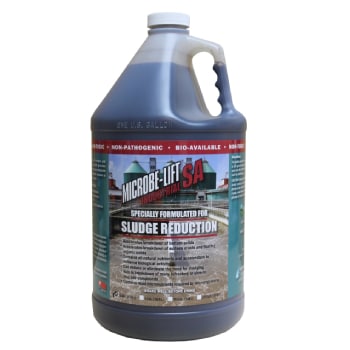Sludge Away
Microbe Lift Sludge Away
- Accelerates breakdown of bottom solids
- Accelerates breakdown of surface crusts and floating organic solids
- Contains all natural nutrients and accelerators to enhance biological activity
- Can reduce or eliminate the need for dredging
- Aids in breakdown of many refractory or slow to degrade compounds
- Contains most micronutrients required by microorganisms
MICROBE-LIFT INDUSTRIAL / SA is a blend of humates and humic substances and benficial bacteria which promotes enhanced microbial oxidation of difficult and slow-to-degrade organic waste matter, resulting in a significant increase in biomass activity in degrading waste organic solids.
MICROBE-LIFT INDUSTRIAL / SLUDGE-AWAY (SA):
- Improves aerobic and anaerobic digester efficiency
- Can significantly reduce waste sludge production in biological wastewater treatment systems
- Enhances settling / supernating in digesters and clarifiers
- Reduces gaseous odor production
- No synthetic chemical constituents
- Works in a wide range of temperatures
- Effective in pH range of 4.0 to 10.0
- Accelerates biological organic oxidation
Bio-Available – Non-Toxic – Non Pathogenic

MICROBE-LIFT INDUSTRIAL / SA contains natural, organic-based humates and humic consistuents. These natural compounds include most biological compounds synthesized by living organisms, including plants. They significantly speed microbial response to difficult-to-degrade organic matter, resulting in significant reduction in sludge volumes through rapid oxidation of many slow-to-degrade compounds.
MICROBE-LIFT INDUSTRIAL / SA improves slude reduction from 20% to 80% over historical system performance and provides reductions in final BOD, COD and SS.
Directions
For solids reduction (wastewater and digesters), apply 2 ppm to 20 ppm, based on influent flow. For optimum performance, use with ML / IND Hi-Count.
CAUTION: Keep out of reach of children. Do not take internally. Avoid contact with eyes. Flush immediately if needed. Use gloves and safety glasses when handling spills. If contact is made, wash with soap and water. If swallowed, drink several glasses of water. Contact physician if any irritation persists.
DESIGNED FOR ALL ENVIRONMENTAL APPLICATIONS
Microbe-Lift IND is a highly active liquid culture consortium designed specifically for use in almost all environmental applications. IND select cultures promote increased biological degradation capabilities in all types of designs of biological wastewater systems, open lagoon and polluted environments. IND consortium is very effective in degrading hard degradable compounds such as fatty acids, various chemical compounds, hydrocarbons and fibrous matters that indigenous bacteria often unable to degrade them, hence result in system performance deficiency. These cultures resist shock loads of chemicals, reducing upsets and kills, which may occur in waste-water treatment systems. This translates to improved system performance, stability and reduced final effluent BOD, COD and TSS. Microbe-Lift IND will breakdown fats, oils and grease in lift stations along with reducing hydrogen sulfide and ammonia odors.
MAINTAIN AND IMPROVE PERFORMANCE
ACCELERATED DEGRADING RATES
SYSTEM RECOVERY
ELIMINATES ODOR
WASTE WATER SYSTEM STABILITY
IMPROVES SOLID SETTLEABILITY
REDUCES BOD, COD, AND SS, IN FINAL EFFLUENT
IMPROVES NITRIFICATION
Choose A Product That Best Fits
Your Wastewater Application
| PRODUCT | LIFT STATIONS | TREATMENT PLANTS | GREASE TRAPS | PONDS & LAGOONS |
|---|---|---|---|---|
| IND | X | X | - | X |
| S/A SLUDGE AWAY | X | X | - | X |
| OC | - | X | - | - |
| N1 | - | X | - | - |
| DGTT | X | - | X | - |
| WW | - | X | - | - |
| GT | - | X | - | - |
Get a Custom Quote
Fill out the form below.
Is Recycled Sewage Water Safe for Drinking?
All communities need water to drink. And, although we may not always like to think about it, all communities produce sewage water. Fortunately, this sewage water can be recycled – but is recycled sewage water safe for drinking? Read on as we explore this in more detail.
6 Cheapest Wastewater Treatment Technologies
It’s natural to look for the cheapest wastewater treatment methods. While treatment is vital, you also have a budget to consider, so you need to think about how you can reduce the cost of your operations. Read on to learn more about how this can be achieved.
Wastewater Treatment Using Bacteria: What, Why, and How
Wastewater treatment is crucial across the country, providing residential communities and commercial operations with the services they need to function at their best. But what’s the role of bacteria in all of this? Bacteria wastewater treatment is making a real difference at facilities of all sizes.



